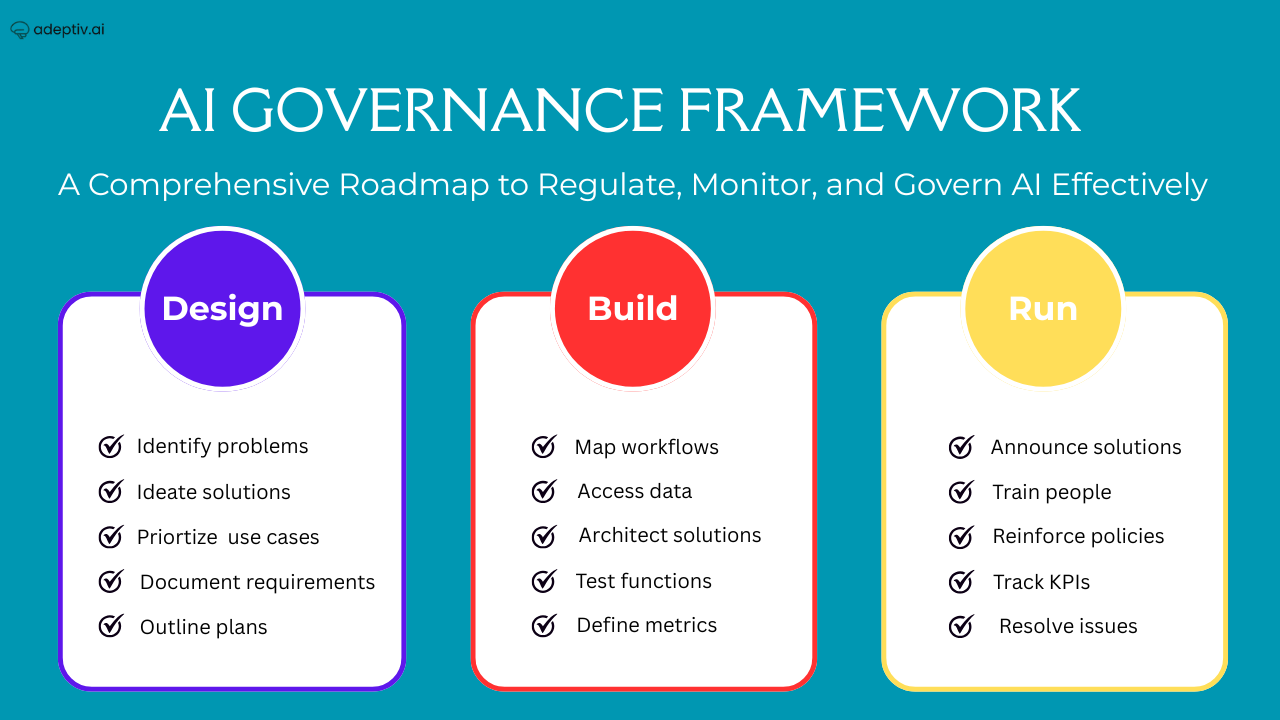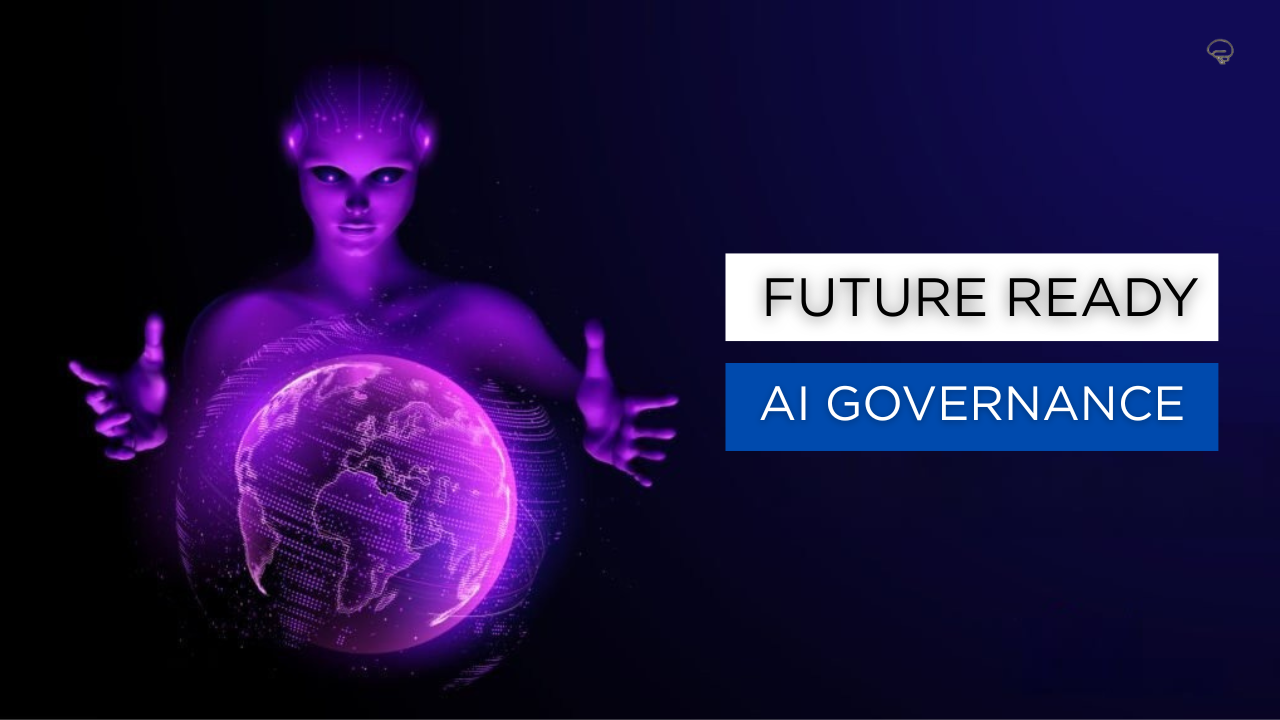Introduction
As artificial intelligence evolves from a computational tool into a pervasive organisational, societal, and geopolitical force, the need for Responsible AI has shifted from a conceptual ideal to an operational imperative. The emergence of generative AI, autonomous decision-making systems, and large-scale, self-optimizing models marks a critical inflection point. AI is no longer merely augmenting human activity—it increasingly directs, evaluates, and governs it.
The velocity, scale, and autonomy of modern AI systems mean that traditional forms of oversight—policy documents, ethical charters, and retrospective audits—are insufficient. Responsible AI today must operate as a rigorous, dynamic, multi-layered governance discipline integrating ethics, compliance, regulation, organisational strategy, risk engineering, and continuous assurance.
This article provides a comprehensive examination of Responsible AI through the lens of Adeptiv AI’s strategic vision, integrating insights from leading institutions such as IBM, Microsoft, Google, AWS, and the Responsible AI Institute, and bridging them with contemporary research, regulatory developments, and industry transformations.
1. Defining Responsible AI
Responsible AI encompasses the policies, technical controls, governance structures, and organisational practices that ensure AI systems are:
- Ethical
- Accountable
- Transparent
- Fair and unbiased
- Secure and robust
- Compliant with regulation
- Aligned with human and societal values
- Safe throughout their lifecycle
But modern Responsible AI extends beyond those foundational principles. As defined by leading frameworks:
IBM’s Perspective
IBM highlights Responsible AI as a fusion of governance, assurance, trust, risk management, and transparency, tightly aligned with business outcomes and compliance obligations.
Microsoft’s Responsible AI Standard
Microsoft emphasises human-centred design, transparency, data governance, harms mitigation, and measurement frameworks through engineering-driven guidance.
Google’s Responsible AI
Google focuses on safety, fairness, interpretability, robustness, and accountability, providing technical tools for practical implementation.
AWS Responsible AI
AWS structures Responsible AI around security, operational governance, risk monitoring, continuous assurance, and compliance alignment.
Responsible AI Institute
RAI defines Responsible AI through independent evaluative standards, certification models, and evidence-based governance structures that organisations can operationalise.
Adeptiv AI integrates these global principles into a unified, enterprise-ready governance architecture that aligns regulatory demands with practical operationalisation.
2. The Importance of Responsible AI
Responsible AI is not a moral accessory. It is a strategic necessity for enterprise risk, global trust, and long-term regulatory sustainability.
Why it matters:
1. Protection against systemic risks
Unregulated or poorly governed AI exposes organisations to severe financial, legal, ethical, and reputational harm. Model hallucinations, bias amplification, data leakage, adversarial vulnerabilities, and misuse all present systemic risks.
2. Regulatory compliance
Governments worldwide—EU, US, UK, Singapore, Canada, UAE—are deploying expansive AI regulations. Non-compliance threatens penalties, sanctions, and blocked market access.
3. Trust and brand credibility
Responsible AI directly influences public trust, user adoption, investor confidence, and enterprise reputation.
4. Workforce transformation
ILO’s research highlights the impact of AI on labour rights, workforce fairness, and digital working conditions.
5. Innovation continuity
EY highlights that companies with Responsible AI frameworks outperform peers in innovation, ROI, risk mitigation, and operational resilience.
6. Cross-border operations
Global supply chains and international business models require harmonised AI governance to avoid regulatory fragmentation.
Responsible AI is not merely an ethical commitment—it is the foundation on which sustainable AI-driven enterprises are built.
3. Historical Context of Responsible AI
The Responsible AI movement evolved through several phases:
Phase 1: Early algorithmic ethics (1990s–2010)
Academic research on algorithmic bias, transparency, and data ethics began shaping early concerns around accountability.
Phase 2: Governance foundations (2016–2019)
This period saw the birth of formal AI ethics guidelines:
- OECD AI Principles
- IEEE Ethically Aligned Design
- EU High-Level Expert Group guidelines
- Corporate ethics boards from Google, Microsoft, IBM
- Institutional commitments from research bodies and think tanks
Phase 3: Regulatory acceleration (2020–2023)
AI adoption surged globally, prompting:
- EU AI Act
- NIST AI Risk Management Framework
- UK Algorithmic Transparency Standards
- Canada’s Directive on Automated Decision-Making
- Global labour organisations evaluating AI’s workplace impact
Phase 4: The generative AI upheaval (2023–2024)
The explosive rise of generative AI exposed:
- Data provenance challenges
- Hallucination risks
- Intellectual property conflicts
- Autonomous agent behaviour
- Dual-use risks
Phase 5: The accountability revolution (2025 onward)
Leading entities (IBM, AWS, Microsoft, Google, Responsible AI Institute) now champion:
- Continuous assurance
- Independent certification
- Real-time monitoring
- AI supply-chain risk management
- Enterprise governance platforms
- Multi-layer technical and policy frameworks
Responsible AI has evolved from philosophy to policy, and now from policy to practical, enforceable governance.
4. Current Research and Advancements in Responsible AI
A new era of Responsible AI research is unfolding, marked by a shift toward measurable, evidence-based controls.
Key advancements include:
A. Reproducibility and Verification
Reproducibility has emerged as a foundational governance requirement.
AI systems must be:
- Verifiable
- Traceable
- Explainable
- Audit-ready
This aligns with:
- Responsible AI Institute certification models
- Google’s data lineage frameworks
- Microsoft’s Model Cards and Data Cards
- AWS AI governance architecture
B. Continuous Monitoring and Assurance
Modern Responsible AI is not episodic—it is continuous.
Systems require:
- Real-time fairness monitoring
- Drift detection
- Behavioural analytics
- Risk alerts and escalations
- Autonomous guardrails
IBM, AWS, and Adeptiv AI have emphasised continuous assurance as the next frontier.
C. Agentic AI Oversight
Agentic AI introduces profound governance challenges:
- Multi-step reasoning
- Autonomous decision planning
- Environmental adaptation
- Self-directed optimisation
Agentic oversight requires:
- New risk scoring paradigms
- Safety constraints
- Intent-based guardrails
- Scenario stress testing
D. AI in the Workplace
ILO’s research highlights:
- Algorithmic transparency for workers
- Explainability in HR and management systems
- Labour governance
- Rights-compliant AI evaluation
Workplace AI ethics is now central—not peripheral—to Responsible AI.
E. Global Regulatory Convergence
DCO, EU, OECD, NIST, UNESCO, and national governments are moving toward aligned governance models.
5. Notable Inventions, Standards, and Frameworks in Responsible AI
From major research institutions to cloud providers, global leaders have developed frameworks shaping modern Responsible AI.
A. IBM Responsible AI Framework
IBM advances a governance-first approach incorporating:
- Ethical principles
- Risk assessments
- System transparency tooling
- Lifecycle governance
- Model documentation
IBM emphasises hybrid-cloud scale governance, workforce impact analysis, and operational responsible AI.
B. Microsoft Responsible AI Standard (RAI 2.0)
One of the most comprehensive industry frameworks, focusing on:
- Human-centred development
- Impact assessments
- Data governance
- Safety testing
- Transparency specifications
- Accountability mechanisms
Microsoft’s RAI standard is considered a benchmark for enterprise operationalisation.
C. Google’s Responsible AI Toolkit
Google provides:
- Fairness Indicators
- Explainable AI tools
- Data Cards and Model Cards
- Interpretability frameworks
- Robustness evaluators
These tools enable measurable and traceable AI development.
D. AWS Responsible AI Guidance
AWS emphasises:
- Security-first design
- Governance and observability
- Explainability tooling
- Auditability
- Compliance-by-design pipelines
Its risk governance capabilities extend across infrastructure, data, and AI workloads.
E. Responsible AI Institute Certification
RAI Institute provides independent, structured evaluation frameworks across:
- Safety
- Accountability
- Fairness
- Transparency
- Social impact
- Governance
This certification is becoming a global standard.
F. Adeptiv AI’s Responsible AI Governance Infrastructure
Adeptiv AI builds on global standards while advancing modern governance:
- Continuous system monitoring
- Automated compliance controls
- Risk-scoring and impact assessments
- Enterprise assurance architectures
- Governance interoperability
- AI accountability tooling
Adeptiv AI positions governance as strategic infrastructure for future-proof AI adoption.
6. The Strategic Role of Responsible AI for Modern Enterprises
Responsible AI is transforming from an ethical imperative into a core business strategy.
Executive priorities now include:
- Regulatory preparedness for EU AI Act and global mandates
- Operational risk reduction through auditability and transparency
- Innovation confidence through validated, safe AI pipelines
- Workforce protection, as highlighted by the ILO
- Consumer trust optimisation
- Supply chain and vendor governance
In a world increasingly governed by automated intelligence, Responsible AI has become the backbone of enterprise stability.
7. The Future of Responsible AI
Modern AI ecosystems demand:
- AI supply chain accountability
- Multi-stakeholder governance
- Systemic risk modelling
- AI policy harmonisation
- Third-party certification
- Emergent behaviour detection
- Global governance architecture
Responsible AI is evolving into:
- A legal requirement
- A reputational differentiator
- A competitive advantage
- A geopolitical priority
- A societal necessity
Adeptiv AI’s mission is to empower organisations with the frameworks, tools, and intelligence needed to lead in this new era.
Conclusion
Responsible AI has moved far beyond the domain of ethical aspiration—it now stands as one of the most consequential governance priorities of the modern digital era. As AI systems evolve into autonomous agents capable of influencing economies, institutions, and human lives at extraordinary scale, the imperative for rigorous, measurable, and continuously adaptive governance becomes undeniable. The convergence of global regulatory frameworks, industry-led standards, labour-centric ethical mandates, and cutting-edge technical safeguards signals a transformative shift: Responsible AI is no longer optional, nor is it a peripheral component of innovation. It is the structural foundation upon which sustainable, trustworthy, and resilient AI ecosystems must be built.
For enterprises, policymakers, and technology leaders, the path forward is clear. Responsible AI must be operationalised with the same diligence, investment, and strategic foresight historically reserved for cybersecurity, financial governance, or national infrastructure. Organisations that embed Responsible AI as a core business capability—supported by advanced assurance, lifecycle governance, transparent oversight, and cross-functional accountability—will not only reduce risk but also unlock accelerated innovation, greater stakeholder trust, and long-term competitive advantage. In this new era, leadership belongs to those prepared to treat Responsible AI as both a societal mandate and a strategic differentiator—and Adeptiv AI is committed to empowering that transition with precision, integrity, and global vision.
FAQs
1. What is Responsible AI?
Responsible AI refers to the frameworks, practices, and governance structures ensuring AI systems are safe, transparent, ethical, compliant, and aligned with human values throughout their lifecycle.
2. Why is Responsible AI becoming more important now?
The rise of generative and agentic AI systems has intensified risks, expanded regulatory scrutiny, and increased the societal impact of AI, making robust governance essential.
3. How do companies implement Responsible AI?
Through integrated governance frameworks including data governance, continuous monitoring, transparency tooling, risk assessments, accountability structures, and compliance automation.
4. Which global organisations are leading Responsible AI efforts?
Google, Microsoft, IBM, AWS, Responsible AI Institute, OECD, NIST, DCO, and Adeptiv AI are among the leaders shaping Responsible AI standards and operationalisation.
5. How does Responsible AI support innovation?
Responsible AI reduces systemic risk, strengthens trust, ensures compliance, and provides operational guardrails, enabling organisations to innovate without compromising safety or integrity.



